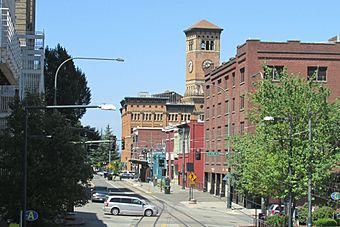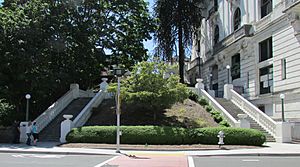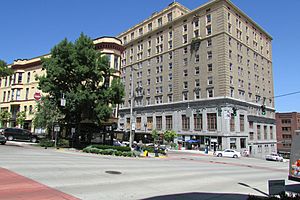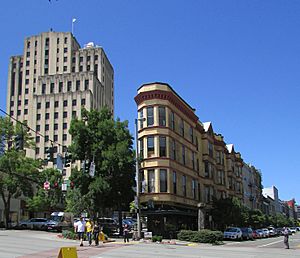Old City Hall Historic District facts for kids
Quick facts for kids |
|
|
Old City Hall Historic District
|
|

Pacific Street looking north
|
|
| Lua error in Module:Location_map at line 420: attempt to index field 'wikibase' (a nil value). | |
| Location | Roughly bounded by St. Helens Ave., Court C, freeway spur, 7th and 9th Sts., Tacoma, Washington |
|---|---|
| Area | 16.5 acres (6.7 ha) |
| Architect | Darmer, C.A.; Et al. |
| Architectural style | Late 19th And 20th Century Revivals, Italianate, Second Renaissance Revival |
| NRHP reference No. | 77001352 |
| Added to NRHP | December 23, 1977 |
The Old City Hall Historic District is a special area in Tacoma, Washington. It sits on a hill overlooking Commencement Bay. This district is home to many old and important buildings. These include the Old City Hall and the Northern Pacific Office Building. The Pantages Theatre and the Winthrop Hotel are also nearby.
The streets in this district are set up so that most building entrances face north and south. Buildings often share walls and go deep into the block. This means there are not many alleys here. Most businesses face east, especially on Pacific Avenue. The west sides of buildings are usually their backs. The land is flat near Pacific Avenue. But Commerce and Broadway streets are on a steep hillside. So, a building that looks like one story on the west side might actually be three stories tall on the east side!
Many buildings in the district are very tall and stand out. This creates cool views within the area. If you look north along Broadway, Commerce, or Pacific streets, you'll see the Elks Temple, Old City Hall, and Northern Pacific Office Building. Looking south along Broadway, you'll see the Winthrop and Bostwick Hotels.
There are only a few open spaces in this busy district. One is a parking lot where a building once stood. That building was destroyed by fire. Other open spots on Commerce Street might never have had buildings built on them.
Contents
Cool Buildings to See
Pacific Avenue
Many buildings here show off styles like Italianate or a mix of different designs. You can see some of the most classic looks between 726 and 736 Pacific Avenue. The Weeks Building and the Davie Building still have their original ground-floor shops. Many windows in this area have a rounded top, sometimes with fancy decorations.
Northern Pacific Building
In 1873, Tacoma, Washington became the main hub for the Northern Pacific Railroad. This was because Tacoma had a great deep-water port. It was perfect for trade with places like the Far East. The railroad's docks were below the hill where the Northern Pacific Headquarters building stands. Many hotels and boarding houses grew up around here. They served people arriving in the city by train or ship.
Commerce Street
The buildings along Commerce and Broadway streets often have simple brick and glass designs. These are common for garage buildings. The Motoramp Garage is a good example of this style. The Morris Motors Building and the Colonial Hotel also show some of these features.
Old City Hall
The Old City Hall is one of the most important buildings in the district. It gives the area its name.
Spanish Steps
The Spanish Steps are a very important feature on Commerce Street. They are located south of the Elks Temple. These steps make it much easier for people to walk from Broadway to City Hall. Without them, it would be a long walk around several blocks. The steps were first built to meet fire safety rules for the Elks Temple. But they quickly became vital for people walking through the city. In 1936, the Elks Club tried to close the steps. But city officials stepped in. They said the steps were a public street, showing how important they were for everyone.
Broadway
Elks Temple
The Elks Temple stands out because it's so big, white, and detailed. It's built in the Second Renaissance Revival style. The building rises from Commerce Street. Its first floor has a rough, stone-like look. The main entrance is on Broadway. This entrance has three sections, each with a rounded window. The second-story windows have small iron balconies. These balconies are supported by fancy brackets. The sections are separated by tall, thin columns called pilasters. These columns have decorative tops.
Above the second-story windows, there's a decorative band. On top of that is a large wall with ornaments. The south side, facing the Spanish Stairs, has five sections. Some windows on this side are rectangular. Others are like the ones on Broadway.
Winthrop Hotel
The opening of the Winthrop Hotel was a huge event for Tacoma. It was named after Theodore Winthrop, an early explorer. He was the first to call Mount Rainier "The Mountain" or "Mt. Tacoma." The hotel was a symbol of hope and what the city could achieve. Local people funded and built it. A newspaper article from 1928 said the hotel had a unique "Northwestern" feel. It offered hospitality that felt truly local. The hotel operated until the early 1970s. Then, it was turned into apartments for senior citizens.
The Winthrop Hotel is a nine-story building made of brick and concrete. It helps anchor the southwest part of the district. Most of the building is made of tan brick. It has a U-shaped design. The main part sits on a wide, two-story base of gray terra cotta.
The first floor on Commerce Avenue is plain. The second floor has tall windows with columns on each side. Between the columns, above the windows, are pairs of decorative creatures called griffins. A decorative band goes around the whole building above these columns. The small windows above this band are also decorated with gray terra cotta. The next four floors have plain windows. Above the seventh floor, there's another decorative band of tan stone. The windows on the top floors have fancy frames made of the same stone. The space between the eighth and ninth-floor windows has a decorative swag. The building's top floor is a lighter shade of brick. It has more fancy details like pilasters and decorative brickwork. A railing sits on top of the very highest part of the building.
St. Helens Street
Bostwick Hotel
The Bostwick Hotel is one of the most interesting main buildings. Henry Clay Bostwick built it in 1889. It sits on a triangular corner where St. Helens, Broadway, and Ninth Streets meet. It's the only one left of three buildings built at the same time. The other two were the Tacoma Theater and the Gross Bros. Store. This building boom helped Tacoma's downtown grow in the 1890s. The hotel rooms were on the top three floors. The ground floor housed the Western Trust Company of Tacoma. The building has a lot of texture and a repeating pattern of sections. This is made even stronger by a pointed roof on every other section. A low wall connects these roofs around the building. The building's surface was covered with boards and moldings. These divided it into many rectangles and squares.
In 1924, big changes happened. A layer of stucco covered the decorative panels. Two sections at the north end were removed. The ground-floor shops have been made larger. But the building still looks very similar to when it was first built.
Fireman's Park
In 1894, Fireman's Park was built. This was three years after the fire station was finished. The fire station was the main headquarters for the Tacoma Fire Department until 1968. The park was on a triangular piece of land north of the station. This park was the first in downtown Tacoma. It overlooked Commencement Bay. It was a grassy area with many original fir and cedar trees. Memorial trees and a rose garden were planted there. Ivy grew all over the fire station. The park became known as "pretty little Firemen's Park."
Two special features in the park are Fawcett's Fountain and the Tacoma Totem Pole. The fountain was given to the city in 1908 by A. V. Fawcett, an early Tacoma Mayor. He wanted to make sure everyone could get a cool drink of water. It's a pile of rough stones with three drinking fountains. It was moved to Fireman's Park in the 1940s. Now, it's in a park between the Northern Pacific Headquarters building and the Bradley Hotel. It has been fixed and works again.
Building Changes Over Time
The most common changes to buildings in the district are at the street-level shops. Sometimes, these changes are small. For example, a single sign might connect different-looking shops. Other times, the changes are bigger. A new brick front might be added to a building. This new front might not match the building or its neighbors at all.
Some changes are not easy to spot. For example, a decorative top part of a building (called a cornice) might be removed. This often happens for safety reasons, like protecting against earthquakes. Other changes are more lasting and can damage the original look. Many historic buildings in the district have been changed so much they are hard to recognize. These changes usually don't affect how the whole district looks. This is because the buildings still line up the same way. Often, an old building is just covered with a new material.
Building Styles
Newer buildings and changes to old ones are what make this district different from the areas around it. Especially along Pacific Avenue. Within the district, the buildings' old styles blend together well. Even with some changes, the area still feels connected. The styles from the late 1800s mix to give you a glimpse of an older time. It's like stepping back in time to see a small part of history.
Architects Who Shaped the District
We know the names of the architects who designed the most important buildings here. Their work covers the entire history of the district. Some were architects who lived and worked in Tacoma. Others were famous architects from the East and Middle West. Their designs show their training. Some learned by working with other architects. Others studied at famous schools like the Beaux Arts in Paris.
- Charles B. Talbot started designing the Northern Pacific Headquarters building in 1886. He was an architect for the railroad. He was also a Vice President and a photographer. He is known for his photos that show how the railroad was built in Washington State.
- Hatherton and McIntosh from San Francisco won a contest in 1890. They were chosen to design the Tacoma Chamber of Commerce building. This building was supposed to be where the Old City Hall is now. But the land was swapped. So, the Chamber of Commerce building ended up where the Winthrop Hotel is. The Old City Hall's cornerstone says Hatherton was its architect. He was also the official architect for San Francisco and designed its city hall.
- C. A. Darmer and Frederick Heath were two architects in Tacoma. They both worked in the city for many years. C. A. Darmer was born in Germany and trained there. He worked for firms in San Francisco and Portland, Oregon. He came to Tacoma in 1884. In 1885, he started a partnership. Darmer designed many buildings in Pierce County and Western Washington State. His early work in the Old City Hall Historic District can be seen on the west side of Pacific Avenue (1886–1888). Later, he designed the Bradley Garage (1906) and the Olympus Hotel (1909).
- Heath and Twichell designed the Park Hotel in 1909. Heath was the official architect for the Tacoma School District. He is known for redesigning the Tacoma Land Company Hotel. This hotel became Stadium High School. He also designed the stadium itself.
- E. Frere Champney designed the Elks Temple. He graduated from the École des Beaux-Arts in 1900. He worked for a firm in Buffalo, New York. He became the main designer for their projects at the Pan-American Exposition. Later, he worked for the government. He designed buildings for the St. Louis (1904) and the Lewis and Clark Centennial Exposition (1905) in Portland, Oregon. In 1907, he moved to Seattle.
- W. L. Stoddard from New York City was chosen to design the Winthrop Hotel. He was picked because he had designed other large hotels. Stoddard graduated from Columbia University. He started his own practice in 1908. He designed other hotels like the Lord Baltimore in Maryland.
|




